- Wondering how to get Monopoly GO! free rolls? Well, you’ve come to the right place. In this guide, we provide you with a bunch of tips and tricks to get some free rolls for the hit new mobile game. We’ll …
Best Roblox Horror Games to Play Right Now – Updated Weekly
By Adele Wilson
Our Best Roblox Horror Games guide features the scariest and most creative experiences to play right now on the platform!The BEST Roblox Games of The Week – Games You Need To Play!
By Sho Roberts
Our feature shares our pick for the Best Roblox Games of the week! With our feature, we guarantee you'll find something new to play!Type Soul Clan Rarity Guide – All Legendary And Common Clans Listed!
By Nathan Ball
Wondering what your odds of rolling a particular Clan are? Wonder no more, with my handy Type Soul Clan Rarity guide.
Infinite Crisis Review
Comic book stories are a great backdrop for video games. Not only do you have thousands of canonical characters and decades of continuity to play with, but each of those characters and storylines have multiple versions thanks to the many universes of DC and Marvel Comics.
Infinite Crisis marked the return of the “multiverse” concept to the world of Superman, Wonder Woman and Batman after a long absence. Now, Turbine has made a game by the same name, loosely based on the events of that storyline, and in doing so picked the perfect genre to employ the menagerie of metahumans at their disposal.

Turbine is best known for its massively multiplayer games (Dungeons and Dragons Online, Lord of the Rings Online and Asheron’s Call). Infinite Crisis is, however, that newest of multiplayer fads – a MOBA. That’s short for “multiplayer online battle arena,” and encompasses games like Dota 2 and League of Legends. Those two genre heavy-hitters may be vastly different from one another, but Infinite Crisis definitely mimics the latter.
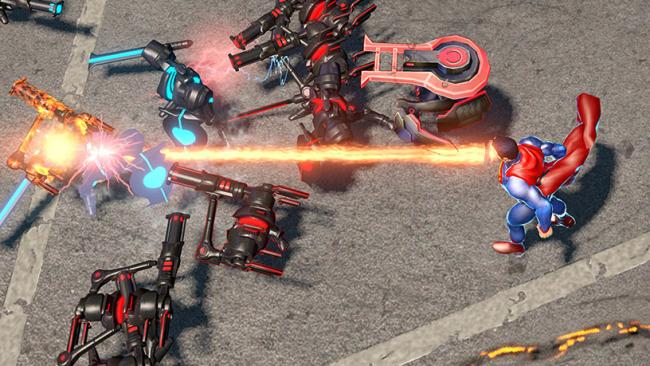
Justice League of Legends
Comic book stories are a great backdrop for video games. Not only do you have thousands of canonical characters and decades of continuity to play with, but each of those characters and storylines have multiple versions thanks to the many universes of DC and Marvel Comics.
Infinite Crisis marked the return of the “multiverse” concept to the world of Superman, Wonder Woman and Batman after a long absence. Now, Turbine has made a game by the same name, loosely based on the events of that storyline, and in doing so picked the perfect genre to employ the menagerie of metahumans at their disposal.

Turbine is best known for its massively multiplayer games (Dungeons and Dragons Online, Lord of the Rings Online and Asheron’s Call). Infinite Crisis is, however, that newest of multiplayer fads – a MOBA. That’s short for “multiplayer online battle arena,” and encompasses games like Dota 2 and League of Legends. Those two genre heavy-hitters may be vastly different from one another, but Infinite Crisis definitely mimics the latter.
Two teams of five heroes (and/or villains) push from one side of a map to another, fighting through cannon fodder minions and high-damage towers to access the others’ home base. As you fight, you earn cash and experience to improve your character over the course of battle.
The potential for variety among heroes with every world in the DC multiverse to play with is astounding. For now, however, Turbine has limited themselves to six.
At the start of each match, heroes and villains alike swing, fly, blink, or burst forth into battle with flashy (though graphical uninspired) presentation that highlights their unique identities.
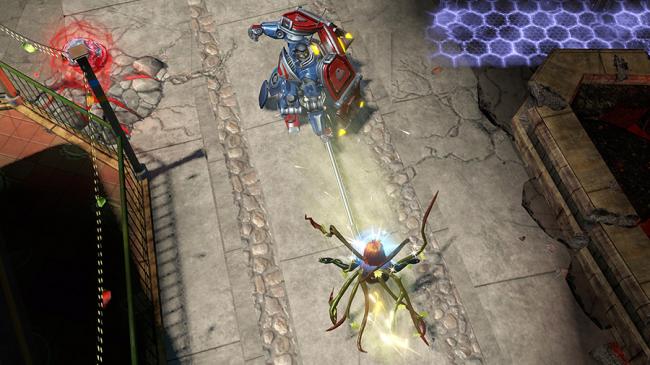
There’s the classic universe, featuring heroes we all know and love. The “Nightmare” sports a gothic world of legendary monsters, while the “Mecha” heroes are based in science fiction. “Gaslight” is your obligatory steampunk universe, “Atomic” brings a post-apocalyptic feel and in the “Arcane” variant you’ll spot the classic character with powers based on magic.
Usually, these worlds would be cordoned off to their own devices, but this is a Crisis tie-in. Your Nightmare Batmans and your Atomic Wonder Womans are all mixed up and ready to duke it out – sometimes against themselves.
Right now, that’s the weirdest thing about Infinite Crisis. There may be a multitude of heroes to mine, but because the game is steeped in the League of Legends model (where only a few characters are free at a time, and the rest must be purchased) the game allows for mirror matches. So, despite the promise of the Infinite Crisis title you’ll still likely see classic Wonder Woman go toe-to-toe with… classic Wonder Woman, more often than not.
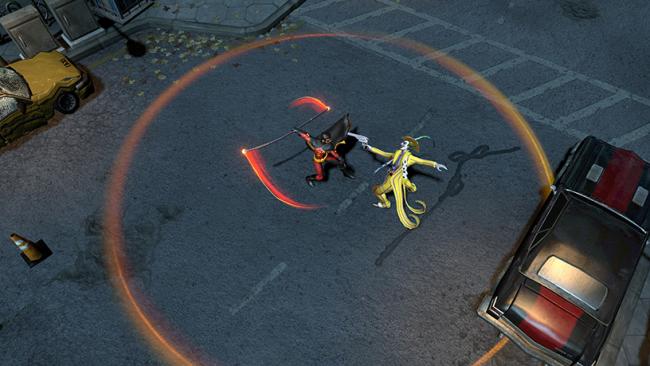
That’s a major distinction in a competitive genre so dependent on team composition. It’s also a bummer for the comic book fan in me, as I’d like to see more of the goofier heroes and villains, such as the bulbous, meat cleaver-wielding Gaslight Joker, find some time in the spotlight.
As it’s still the early days of the open beta, however, the available roster is predictably paltry in comparison to its competition. As a result, mirror matches between teams using the free characters are the rule, not the exception. Maybe this will change as more characters are introduced and Turbine can be slightly less miserly, but for now I find multiple copies of a single character fighting in the same match strategically and aesthetically boring.
What works in Infinite Crisis‘ favor is that this might not matter to its core audience. It’s smaller, leaner, and faster than something like, say, Dota 2 (where most of my personal MOBA experience derives).
Champions are far more fragile and their abilities (each unit has four, plus a passive skill and two “stolen powers” that can be equipped by anyone before a match) are basic.
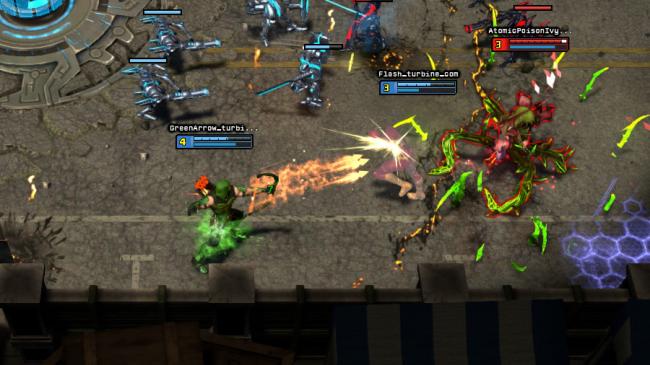
The focus is definitely on dealing of damage in different ways, as opposed to the often bizarre, highly specific attacks found in other games of this type. Furthermore, you can purchase items at any allied structure rather than the home base, location-based abilities fire automatically in whatever direction your character is facing, and characters are just generally very fragile.
It’s unpleasant for veteran MOBA-ers who will no doubt find the units simple and similar. However, it’s great news for players that want to get into MOBAs but don’t yet know their jungles from their fountains (if you didn’t understand that last sentence, then I’m talking about you).
Actually, I’d prefer it if the game was even more fast-paced. Towers (the primary means of defense in any MOBA) are disproportionately buff compared to player characters. They take ages to remove, and the glassier of glass cannon champions can only survive two or three hits of sustained fire in the early goings.
Like in any MOBA, your ever-marching minions shield you long enough to whittle away at the structures, but in Infinite Crisis they melt in a flash. This drags matches out far longer than the player-on-player fights intimate, and feels poorly balanced.
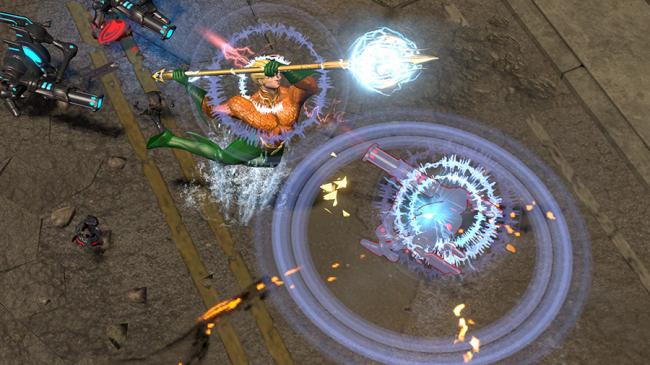
The average Dota match lasts around 45 minutes to an hour. InfiniteCrisis‘ average is on the low end of that spectrum, but if Turbine could shave off another 15 minutes by rebalancing towers this would be a wonderful, speedy alternative to more involved titles.
Infinite Crisis, like the comic before it, is a theoretically beautiful merging of concepts. Worlds (along with their associated heroes and villains) collide with energetic aplomb, but design and technology beneath them are too thin to support the weight of such iconic characters.
MOBAs are constantly tweaked, balanced and expanded, and that bodes well for a franchise with so much variety to offer. If it can deliver on that promise as the beta progresses, it could be a fantastic “My First MOBA” for genre newcomers.

The good

The bad
More articles...
Monopoly GO! Free Rolls – Links For Free Dice
By Glen Fox
Wondering how to get Monopoly GO! free rolls? Well, you’ve come to the right place. In this guide, we provide you with a bunch of tips and tricks to get some free rolls for the hit new mobile game. We’ll …Best Roblox Horror Games to Play Right Now – Updated Weekly
By Adele Wilson
Our Best Roblox Horror Games guide features the scariest and most creative experiences to play right now on the platform!The BEST Roblox Games of The Week – Games You Need To Play!
By Sho Roberts
Our feature shares our pick for the Best Roblox Games of the week! With our feature, we guarantee you'll find something new to play!Type Soul Clan Rarity Guide – All Legendary And Common Clans Listed!
By Nathan Ball
Wondering what your odds of rolling a particular Clan are? Wonder no more, with my handy Type Soul Clan Rarity guide.







